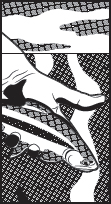Because only tools need tools.
WHAT YOU’LL NEED
• Because of its inherent dangers, hand fishing should be your last resort in a survival situation. Even if you’re stranded with only the clothes on your back, you may be able to come up with improvised fishing tackle from materials at hand.
• The simplest tool is a pointed stick, but spearfishing is difficult to master, demanding both endless patience and lightning reflexes. Although a springy branch can serve as a fishing rod, it’s hard to find a workable substitute for fishing line. Ordinary string or sewing thread will likely break the moment you get a strike. Dental floss will work in a pinch; it’s surprisingly strong, especially if you braid two strands together. Fashion your hook from a safety pin, or even a thorn.
• For the amateur angler, though, the most effective survival tool is a T-shirt. Roll the sleeves in toward the neck, making a triangle. Tie off the triangle’s point tightly. Then poke a few holes in the bottom hem and weave a supple branch through, making a half-hoop that will hold the bottom of the shirt open. In just minutes, you’ve got a handy fishing net and are ready to catch some supper.

HOW TO DO IT
1.Before you can catch a fish, of course, you and it have to be in the same place. There are two ways to make that happen: either go to where the fish are, or make them come to you. The latter option is a lot less hazardous for the angler, and is reputed to be quite effective for catching brook trout. Look for a spot along the bank where the water is relatively deep and the current is slow. Lie down on your side, with one arm in the water. Get comfortable, because you’re going to be there a while.
2.Before you can catch anything, you’ve got to let your arm go cold. Fish can detect your body heat, and will avoid you until your skin cools to match the ambient temperature.
3.Wiggle your fingers slowly and gently to mimic the movement of a distressed insect.

4.When a fish approaches, stay cool. Move your hand slowly into position under the fish. Some practitioners recommend rubbing your fingers along the fish’s belly to hypnotize it—a practice known as “tickling”—but you’re in a life-or-death situation, and there’s no time for finesse. Just get your palm under the fish, fingers curled upward.
5.Don’t try to close your fist—the fish will most likely slip through. Instead, form a scoop with your hand and, in one quick motion, flip the fish up onto the bank.

6.If you’re after catfish, the technique of choice is “noodling.” This works best in late spring and early summer—spawning season, when catfish stay close to their eggs. You’ll have to wade full into the stream or pond and stake out a spot near a nest to await your prey. When a catfish comes close, don’t try to grab the body. You’re looking to hook your fingers into the gills, just behind the head; there’s enough bone and cartilage there to afford you a solid grip.

A SHOCKING TALE
On November 9, 1967, 17-year-old Brian Litasa touched a live “ultra-high-voltage” power line in Los Angeles. Estimated shock: 230,000 volts. It’s the largest electric shock ever received by a human…who lived through it.
